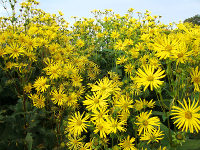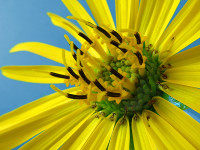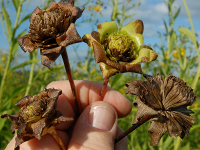The Plant
The cup-plant (scientific name: Silphium perfoliatum) is a member of the composite family (scientific name: Asteraceae) and originates from the wet plains of Eastern North America. It is a herbaceous perennial, growing up to 3 m in height every year. The characteristics are: a tetragonal, sharp-edged stem, opposite heart-shaped leaves, which are 20-30 cm long, with coarsely dentate edges, and connate-perfoliate at their base. Due to very short, stiff hairs their surface has a rough touch. The name „cup-plant“ derives from the fact that the leaves are conjoined with their lower stalk-base forming a small cup-like structure. Another common name of the species is Perfoliate Sylphie, because the stalks seem to grow through the connate leaf bases (lat.: perfoliatum = enclosed by leaves). In the first year the plant grows into a big, leafy roesette, up to 70 cm in diameter, which covers the soil almost completely.
Between end of July and September the cup-plant produces a cascade of flower heads, each about 6-8 cm wide, starting with one, which will be surmounted first by two, then by 4 and then by 8 more flower heads. The ligules of the 20-25 yellow ray flowers at the edge of the flower head are about 2,5-3 cm long; the brownish-yellow disc flowers have no ligules, but are inconspicuous. Only the ray flowers are female and develop an epigynous fruit, which resembles a flat sunflower seed. The central disc flowers are male and produce only pollen and nectar and wither after flowering. The flowers are visited by a large variety of insects gathering nectar and pollen (honey and solitary bees, bumblebees, hover flies, butterflies, moths etc.).
The picture shows the already shriveled, corkscrew-like styles of the female ray flowers at the edge of the flower head (to the right), and the five-lobed, male central tube flowers with dark brown anther tubes, through which grows a sterile, yellow style. These styles have hairswhich push the pollen out of the tube-like disk flowers so that it can be taken and distributed by visiting insects. The flowering sequence is from outside to inside. Between the ray and disc flowers one can recognize green bracts of already wilted male disc flowers. In the center of the flower head, there are still buds of male disc flowers.
During riping time in September and October, the flower head collapses and the seeds fall down to the soil. Since the seeds ripen successively in flower heads of different age, an effective harvest before seed dispersion so far is only possible by hand. For mechanical sowing (pneumatic sowing machine; still tested) the seeds have to be cleaned from spelts, sterile seeds, and flower remains by sieving techniques and a pneumatic separator. For this procedure, old grain fettling machines can also be used successfully.
As perennial herb the cup-plant can become very old, unless it is shaded by trees. In the Botanical Garden of the University of Bayreuth, the species grows since 1975 without any damage. Animal pests that could harm the plants are not known in Central Europe.
After the first frost in late autumn the above-ground part of the plant dies (if it has not been harvested before); the rootstock stays alive. During winter, it is resistent to very low temperatures (for example -27 degrees Celsius in Winter 2011/12). In March already, the new reddish buds can be found sprouting from the soil, ready to grow at temperatures above freezing point. By the end of May, the soil is covered by the spreading foliage and the plants are waist-high. Thus soil erosion by wind or heavy rains is avoided. Because of shading effects of the dense foliage, no other plants – i.e. no weeds - can survive beneath a stand of cup-plants.
The cup-plant has a widespread root system, growing up to 2 m in depth, where it can reach and use lower water ressources (fall and winter precipitation).















